1 Unit 1: Introduction to UDL
 After working on this unit, you are expected to be able to:
After working on this unit, you are expected to be able to:
- Define the social model of disability
- List and define the three UDL principles
- Explain the rationale for using UDL in course design
- Demonstrate an understanding of the emergence of UDL

Before we start talking about Universal Design for Learning (UDL), let’s talk about the social model of disability. The social model of disability is a useful framework to apply when thinking about flexible, accessible course design, and which aligns nicely with UDL.
The social model of disability offers an alternative to the individual model of disability. The individual model of disability locates the ‘problem’ of disability in the individual, a deficit that needs a cure or accommodation. This is the model that is found in medical settings, and it is also used at universities and colleges where students need to have a diagnosed disability to be eligible for accommodation.
In contrast, the social model of disability makes a distinction between “impairment” and “disability.” An impairment is a limitation of the physical body (Oliver, 1996, p. 35). For example, a missing limb or sight loss. In contrast, disability has nothing to do with the body. Disability emerges due to “society’s failure to provide appropriate services and adequately ensure the needs of disabled people are fully taken into account” (Oliver, 1996, p. 32).
Ultimately, the social model of disability, which looks at how the design of things outside of a person can cause disability. For example, a person in a wheelchair experiences disability when a restaurant has a stairs-only entrance. However, if those stairs were a ramp, that barrier would disappear.
A blind student experiences disability when their textbook is only available in print and not a digital format that could be read aloud by their screen reader.
 Image description: A stick figure in a wheelchair. Stairs present a barrier to the figure, while a ramp allows the figure to roll up.
Image description: A stick figure in a wheelchair. Stairs present a barrier to the figure, while a ramp allows the figure to roll up.
Attribution: “Social Model of Disability” by MissLunaRose12 is under a CC BY-SA 4.0 Licence.
As such, the social model of disability sees disability emerging when there is a mismatch between a person, their goals, and the tools they have available to them (Mitchell, 2019). With this model, the onus is on the environment to be designed to be accessible, rather than on the individual to adapt to the environment or request an accommodation.
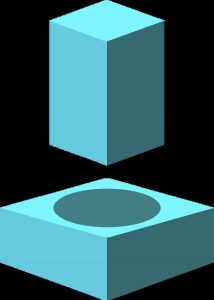
Image description: Mismatch. A rectangle block cannot fit into a round hole.
Attribution: “Doesn’t fit” by Maestrosphere is under a Pixabay licence.
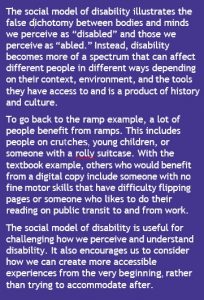
In an article by Jan Wilson (2017), she argues that the classroom, “far from neutral, is constructed for a mythical, ‘able-bodied,’ neurotypical norm that neither reflects nor accommodates the wide range of diverse learners within it, regardless of whether these learners have been diagnosed with a disability.”
What she is getting at here is this problem that comes up when we design for what we think is normal, or what we think is average. The reality is, there is no such thing as a normal or average student.
Students vary greatly in their interests, family situation, culture, background, experience, strengths, and weaknesses. And all students benefit when educational materials are designed to be accessible and inclusive.
Other things that may affect a student’s access include:
- The presentation, format, and structure of information
- Day-to-day life and personal responsibilities
- Access to technology and the Internet
- Unfamiliar or complex technology
Ultimately, by being proactive and intentional about the design of your course, you will be able to improve the learning experience for all your students. And that is something that UDL can help with.
Watch Video: https://youtu.be/_-bA63EGTw8
Video attribution: Learning Barriers by UDL IRN is under a CC BY 4.0 Licence.

Watch Video: https://youtu.be/O_MCvjkd8Jc
Video attribution: UDL in Higher Education by UDL on Campus is under a CC BY 3.0 Licence.
![]()
Universal Design for Learning (UDL) is a set of principles for curriculum development that aim to give all students equal opportunities to learn. UDL provides a blueprint for creating instructional goals, methods, materials, and assessments that work for everyone—not a single, one- size-fits-all solution, but rather flexible approaches that can be customized and adjusted for individual needs.
UDL considers the variability of all learners—including learners who are often relegated to “the margins” of our educational systems. UDL is influenced by a deep understanding and appreciation for individual variability. There is no such thing as an average student. Classroom diversity is the norm, and UDL is a tool to guide designing for that diversity from the very beginning and eliminate the need to “retrofit” with individualized accommodations.
UDL is a framework, not a checklist. It provides a lens that helps to evaluate and select teaching and learning practices. It is a process, a new way of thinking that requires constant reflection and improvement.
Watch Video: https://youtu.be/x76ylvROOq0
Video attribution: Learner Variability by UDL IRN is under a CC BY 3.0 Licence.

Image attribution: “UDL and the brain” by Commonwealth of Learning is under a CC BY-SA 4.0 Licence. It includes three brain icons by CAST, which are under a CC BY-SA 4.0 Licence.
Universal Design for Learning (UDL) is a design framework based on scientific insights into how humans learn. UDL consists of three learning networks that serve as the foundation of the Universal Design for Learning principles. They are as follows:
- Affective networks – why we engage and persist in learning new ideas;
- Recognition networks – what we see, hear, and read, and how we categorize these ideas; and
- Strategic networks – how we organize and express ideas.
The UDL principles align with these three learning networks. When these networks are effectively activated, learning follows.
Principle 1: Multiple Means of Engagement
Principle 2: Multiple Means of Representation
Principle 3: Multiple Means of Action and Expression
Principle 1: Multiple Means of Engagement
Image description: A Filipinx woman with a filtering face mask sits outside on a picnic table, writing in a notebook.
Image attribution: “Filter mask – notebook” by Disabled and Here is under a CC BY 4.0 Licence.
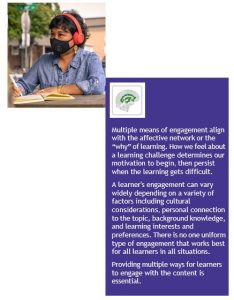
Principle 2: Multiple Means of Representation
Image description: A cartoon figure holding a shopping basket picks between video, audio, graphics, and text to put into their basket.
Image attribution: “Pixel Cells” by manfredsteger is under a Pixabay Licence.

Principle 3: Multiple Means of Action and Expression
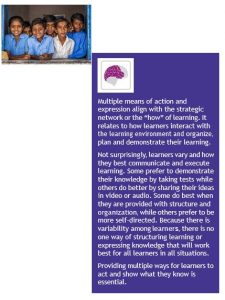

Each UDL principle includes a set of guidelines and checkpoints that offer more information about the principle. These guidelines offer a blueprint for putting the UDL framework into practice.
CAST has created the following table to represent the guidelines. The guidelines in each column are associated with one of the three principles: multiple means of engagement, multiple means of representation, and multiple means of action and expression.
The guidelines are also organized horizontally. The rows from top to bottom increase in complexity and the degree to which they empower learners:
- In the access row, the goal is to provide barrier-free learning opportunities.
- In the build row, teachers and learners work together to enhance learning opportunities.
- In the internalized row, learners are empowered to take charge of their learning.
- The culminating row in the table describes the attributes of an expert learner.
Table caption: The Universal Design for Learning Guidelines (CAST, 2018).
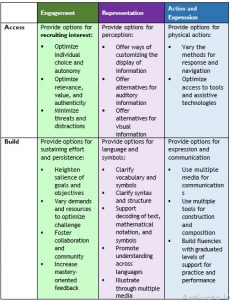
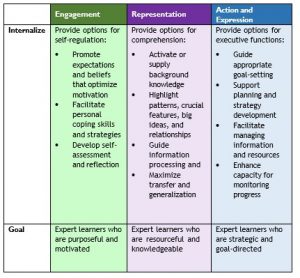
Image Description: A sidewalk curb cut.
Image Attribution: “Curb cut for wheelchair ramp” by Nick-philly is under a CC BY-SA 4.0 Licence.
UDL is influenced by Universal Design in Architecture. Universal Design aims to design physical environments so they are accessible to the widest range of people by default.
An example of universal design in architecture is the curb cut. Curb cuts are where the sidewalk slopes down to meet the street, often by a crosswalk. Curb cuts make it so no one needs to step off a curb to cross the street, which directly benefits people in wheelchairs.
However, it also benefits people with strollers, suitcases, or skateboards. Other examples of universal design in architecture include ramps, automatic doors, and handrails. While each of these things directly makes physical environments more accessible to people with disabilities, they also make the physical environment easier to navigate for everyone.
UDL applies the concept of universal design in physical environments to the design of teaching and learning experiences and materials. It provides an outline of how you can take a proactive approach to plan your courses by thinking about the needs of a range of students.

The UDL framework was developed by CAST. CAST (Center for Applied Special Technology) was founded in 1984 by people who were working in a clinical setting to support students with significant learning needs. They wanted to bring the approaches and technologies they were using into the classroom, as they recognized that the barriers to the student’s participation in class were not the student’s abilities. Instead, the barriers emerged from the design of the environment, curriculum, assessment, and the tools that students had. They wanted to share how barriers could be removed through intentional design and apply brain science research to better support instructors in their approach to teaching (Nelson, 2014).
The UDL framework itself took several years to emerge. In 1988, CAST began focusing on how curriculum design could be improved to better include students with disabilities. And in 1995, CAST began to talk about “Universal Design for Learning” in public talks (CAST, n.d.). Now, CAST is a non-profit educational research and development organization and publisher.

Image description: A Filipinx woman with a filtering face mask sits outside on a picnic table, writing in a notebook.
Image attribution: “Filter mask – notebook” by Disabled and Here is under a CC BY 4.0 Licence.
UDL has the following concrete benefits:
- Reduces or eliminates the need for individual accommodations
- Increases flexibility and options for all students
- Helps focus attention on concrete and specific course outcomes
Let’s look at each of these benefits in more detail.

When a variety of options are provided for all students, there is a strong potential to reduce the number of individual accommodations that are required for students with disabilities. This means that students with disabilities can participate in the course in the same way as all other students. This also can help reduce time and effort by instructors and students in making these special arrangements.
For example, if all students are provided with options for both a take- home exam and a timed test, students with disabilities may find that the take-home exam eliminates their need for separate testing setting to obtain more time. If instructors provide videotapes of their lectures and copies of lecture notes for all students, it could eliminate the need for students with disabilities to digitally record their lectures or to request a note-taker.
![]()
UDL can have great benefits for students with disabilities, but it also can support the learning and success of students that face different barriers. This includes:
- Students for whom English is not their first language
- Students from different cultural backgrounds
- Students who struggle with or dislike reading
With UDL, instructors do not assume that all students learn or communicate their learning in the same way. Instead, they recognize that students will have a variety of learning preferences, strengths and weaknesses, and personal characteristics and contexts that will influence how they take in knowledge, use it, and express it.

In order to provide increased flexibility in course delivery, supports, and assessment, instructors must have a clear understanding of the essential learning outcomes and objectives of their course. This will allow them to clearly identify the skills and knowledge that are critical, and that students are expected to master. From there, instructors can determine options for assessment and recognize what methods of delivery and student engagement will be a good fit for the type of knowledge and skills they are working to develop in students.

Universal Design for Learning (UDL) is a framework for curriculum development that puts student variability at the centre. Rather than requiring students to adapt to the methods of a course, the goal of UDL is to design a course that is flexible enough to adapt to the needs and strengths of students. As such, UDL is compatible with the social model of disability, which sees disability as emerging by design rather than because of individual impairment.
The Universal Design for Learning framework is structured around
three principles that each align with a learning network in the brain:
- Provide multiple means of engagement that aim to activate affective networks in the brain or why we engage and persist in learning new ideas.
- Provide multiple means of representation that aim to activate recognition networks in the brain or what we see, hear, and read, and how we categorize these ideas; and
- Provide multiple means of action and expression that aim to activate strategic networks in the brain or how we organize and express ideas.

- Which of the following is the correct definition of the social model of disability?
a) A framework that sees disability as due to a disabled person’s inability to fit in with society.
b) A framework that sees disability as an individual problem or affliction.
c) A framework that sees disability as due to society’s failure to support and consider the needs of disabled people.
d) All of the above.
2. Which of the following statements does not describe UDL?
a) With UDL, there is no one correct
b) UDL provides a clear checklist on how to make your course inclusive and accessible.
c) UDL recognizes that students are very different from each
d) UDL was inspired in part by the idea of “universal design” in architecture.
3. Which principle of UDL aligns with the “affective” network, or the “why” of learning?
a) Multiple means of representation
b) Multiple means of engagement
c) Multiple means of action and expression
4. True or false? Universal design for learning only benefits students with disabilities.
a) True
b) False
5. What influenced the creation of the UDL framework?
a) Universal design in architecture
b) The experiences of people who were supporting students with disabilities
c) The belief that barriers were due to classroom and curriculum design
d) All of the above
6. What is an example of providing multiple means of action and expression?
a) Give students a choice in whether they demonstrate their understanding through a recorded video, a live presentation, a paper, or a test.
b) Give students a choice in whether they watch a video or read an article.
c) Give students a range of case studies to choose
d) All of the above.

